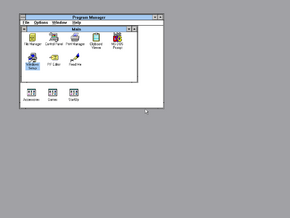Build list legend
Non-existent page
 | |
 | |
| Developer | Microsoft |
|---|---|
| Source model | Proprietary |
| Initial release | Windows 3.1 (6 April 1992) |
| Latest release | Windows for Workgroups 3.11 (8 November 1993) |
| Supported platforms | 16-bit x86[a] (PC/AT, PC-98, FM TOWNS) |
| Kernel type | Monolithic |
| Preceded by | Windows 3.0 |
| Succeeded by | Windows 95 |
Windows 3.1x is a series of Microsoft Windows versions following Windows 3.0 initially released on 6 April 1992. It added TrueType support and included multimedia components installed by default. System stability was greatly increased compared to Windows 3.0, while the user interface was refined and improved. It was succeeded by Windows 95 released in 1995.
Windows 3.1 was originally released in April 1992, and is an incremental update over Windows 3.0. It features minor improvements to the user interface, such as a new set of icons. Support for TrueType fonts, which previously had to be added by installing the Adobe Type Manager, is now available out-of-the-box. Windows 3.1 also includes the multimedia functionality introduced in Windows 3.0 with Multimedia Extensions, which was only available via OEMs with a new computer.
Windows 3.1 was released in part to coincide with the incoming release of Windows NT, and includes support for detecting Win32 PE files in anticipation of the Win32s addon. The LoadModule function, which is responsible for loading NE (New Executable) format files returns an error code when it detects a PE file. WinExec, which calls LoadModule, detects this error code and then invokes Win32s, if available, to execute the file.
Windows 3.1 also introduces 32-bit Disk Access, also known as FastDisk, a feature that supports handling INT13 hard disk calls through a protected-mode VxD rather than thunking to real-mode to execute in the BIOS. However, the built-in FastDisk driver, WDCTRL, only supports standard IDE hard disks (up to 504MB) and a limited set of controllers, though Ontrack Disk Manager 386 and several other utilities supply more-compatible FastDisk drivers.
Aside from the standalone version, Microsoft also released a combined bundle of MS-DOS 5 and Windows 3.1 codenamed Janus,[1] which included minor updates to MS-DOS and Windows installers to create a seamless setup experience. The bundle was eventually updated to include MS-DOS 6 and later MS-DOS 6.2; the updated version was codenamed Jastro – a portmanteau of Janus and Astro, the codename of MS-DOS 6.[2]
Several other special versions based on Windows 3.1 have also been released:
In October 1992, Microsoft released Windows for Workgroups 3.1 (codenamed Sparta or Winball), an updated version of Windows 3.1 that includes a built-in network client. Although networking is already supported by the base version of Windows 3.1, it doesn't actually include any network drivers or client software and requires those to be installed separately in MS-DOS. The box for Windows for Workgroups 3.1 also includes a 10BASE2 network adapter using a BNC connector, which greatly impacted the sales of this version as that standard soon became obsolete in favor of Ethernet over twisted pair.[3]
An updated version, Windows for Workgroups 3.11 (codenamed Snowball) was released in November 1993, which includes 32-bit network drivers as opposed to 16-bit MS-DOS-based ones in the previous version. It also includes other improvements, some of them backported from Windows 95 such as 32-bit file access. This version drops support for the Standard mode, effectively requiring a i386 or better processor.
An update for the base version of Windows 3.1 that updated some components to version 3.11 was also released, although it doesn't include any of the new features and even still supports Standard mode.
Microsoft ended support for all of the Windows 3.1x series on 31 December 2001, except the embedded version, which continued until 2008.[4]
According to Microsoft, the following are the recommended system requirements for Windows 3.1x, including Modular Windows.[5] Windows 3.1 drops support for the 8088 real mode, and Windows for Workgroups 3.11 drops support for the 286 Standard mode. This table takes account retail versions; OEM versions will vary depending on the hardware that it was intended to be installed on.
| Name | CPU | RAM | Storage | Video adapter | MS-DOS version |
|---|---|---|---|---|---|
| Windows 3.1 | 80286 processor | 1 MB | One hard disk with 6 MB of hard disk space | Hercules, CGA, EGA, or VGA | MS-DOS 3.10 and above |
| Windows for Workgroups 3.1 | 3 MB | One hard disk with 8 MB of hard disk space | MS-DOS 3.30 and above | ||
| Windows for Workgroups 3.11 | 80386 processor | ||||
| Modular Windows | 4 MB | One hard disk with 20 MB of hard disk space | MS-DOS 3.22 and above |
Much like previous versions, Windows 3.1x features an Easter egg that shows a list of people involved with the project. The Easter egg can be triggered by repeatedly opening the About box of any application included with Windows, double clicking the logo in the top left corner while holding Ctrl+Alt+⇧ Shift and then clicking the OK button. Upon reopening the About box and double clicking the logo for the second time, the product and system information is replaced with an animated Windows flag and a message reading "Dedicated to all the hard-working people of the Microsoft Windows 3.10 Team!".
Repeating the procedure for the third time results in the same area being replaced by a gray box showing an illustration of a person in a yellow suit presenting scrolling credits with the team members' e-mail aliases. The person's head changes randomly for each invocation between drawings of Bill Gates, Brad Silverberg, Steve Ballmer, and a bear; the last of which is a reference to the team's mascot. After closing the window, it is required to perform the steps above to trigger the Easter egg again.
Build list legend